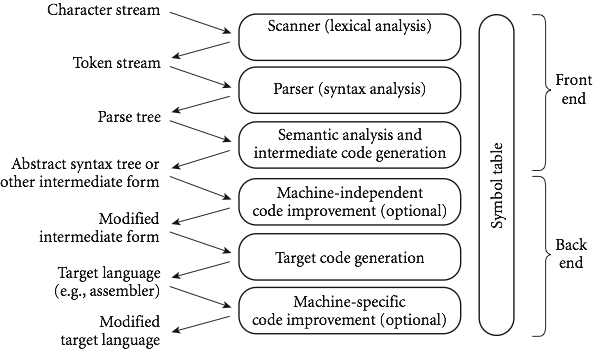Difference between revisions of "Multi-Paradigm Programming and Scripting"
Adelo Vieira (talk | contribs) |
Adelo Vieira (talk | contribs) (→Reflection in Java) |
||
| Line 35: | Line 35: | ||
'''Uses of reflection for software tools:''' | '''Uses of reflection for software tools:''' | ||
| − | |||
*Class browsers need to enumerate the classes of a program | *Class browsers need to enumerate the classes of a program | ||
*Visual IDEs use type information to assist the developer in building type correct code | *Visual IDEs use type information to assist the developer in building type correct code | ||
*Debuggers need to examine private fields and methods of classes | *Debuggers need to examine private fields and methods of classes | ||
*Test systems need to know all of the methods of a class | *Test systems need to know all of the methods of a class | ||
| + | |||
| + | |||
| + | '''Downsides of Reflection:''' | ||
| + | * Performance costs | ||
| + | * Exposes private fields and methods | ||
| + | * Voids the advantages of early type checking | ||
| + | * Some reflection code may not run under a security manager, making code nonportable | ||
Revision as of 19:41, 30 October 2019
- Improved background for choosing appropriate languages
Contents
Compilation vs Interpretation
Phases of Compilation
C++ Inheritance
https://www.w3schools.com/cpp/cpp_inheritance.asp
https://www.tutorialspoint.com/cplusplus/cpp_interfaces.htm
Difference Between Static and Dynamic Binding
https://techdifferences.com/difference-between-static-and-dynamic-binding.html
Reflection in Java
A programming language that supports reflection allows its programs to have runtime access to their types and structure and to be able to dynamically modify their behavior
- The types and structure of a program are called
metadata
- The process of a program examining its metadata is called
introspection
- Interceding in the execution of a program is called
intercession
Uses of reflection for software tools:
- Class browsers need to enumerate the classes of a program
- Visual IDEs use type information to assist the developer in building type correct code
- Debuggers need to examine private fields and methods of classes
- Test systems need to know all of the methods of a class
Downsides of Reflection:
- Performance costs
- Exposes private fields and methods
- Voids the advantages of early type checking
- Some reflection code may not run under a security manager, making code nonportable
Reflection in Java
- Limited support from
java.lang.Class
- Java runtime instantiates an instance of
Classfor each object in the program
- The
getClassmethod ofClassreturns theClassobject of an object
float[] totals = new float[100];Class fltlist = totals.getClass();Class stg = "hello".getClass();
- If there is no object, use class field:
Class stg = String.class;
- Class has four useful methods:
getMethodsearches for a specific public method of a classgetMethodsreturns an array of all public methods of a classgetDeclaredMethodsearches for a specific method of a classgetDeclaredMethodsreturns an array of all methods of a class- The
Methodclass defines the invoke method, which is used to execute the method found bygetMethod
